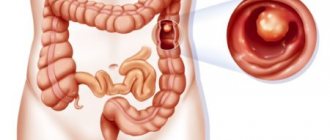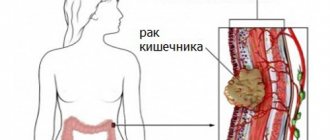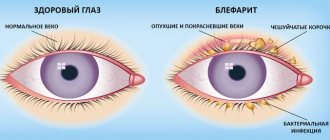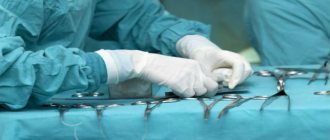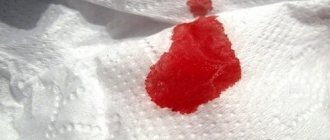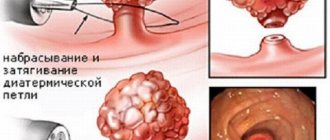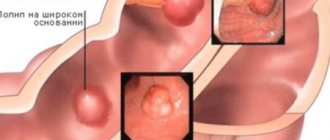The intestine is an essential organ in the digestive system that originates from the stomach and ends at the anus. In the intestines, food is digested from which useful substances are extracted, and the processed product is excreted naturally along with waste and toxins. Sometimes patients turn to a proctologist with organ problems; one of the serious pathologies is rupture of the colon.
The nature of the violation of the integrity of the organ can be of a closed or open type with intra-abdominal and extra-abdominal localization. A rupture inside the colon can be common and may involve nearby organs or the sphincter. The depth of the rupture is noted to the depth of the mucous tissues of the organ, hematomas in the submucosal tissues, and rupture of all layers of the intestinal walls.
Colon injuries
Anatomy of the large intestine
Injury to the rectal organ can occur due to a strong blow to the abdominal cavity. Such phenomena are possible in the event of an accident, explosion, high pressure on a person, or a fall from a high point.
Injury can be different. Starting from strong compression to the occurrence of ruptures in the organ. If a perpendicular blow is applied to the human peritoneum, then most often this leads to a complete separation of the rectum. This is a dangerous injury that can have serious consequences.
Such injuries are difficult to diagnose, since there are many injuries inside. Ruptures near the rectum occur from a gunshot, as well as after application to the stomach with a cutting or stabbing object. Any injury to the rectal organ can only be treated surgically.
Causes
Damage to the rectal organ occurs for a number of reasons:
Specialist
- pelvic bone fractures;
- impaired technique during enemas (damage to the sphincter, mucous tissue);
- severe labor with ruptures of the perineum and rectum;
- wound (gunshot);
- the presence of a foreign object in the anal area;
- injury to the rectal organ from a fall with a blow to the perineum;
- unconventional sex;
- closed injury with internal bleeding of the peritoneum during a fall from a high point;
- spontaneous injury during sudden lifting of a load, provoked by intra-abdominal pressure;
- difficult passage of hard feces;
- accidentally swallowed an object.
Among cases of rupture of the large intestine, injury by a foreign body is most often noted, especially in young children. Therefore, you should watch your baby so that he does not put toys with small parts in his mouth.
Diagnosis and treatment
Primary diagnosis includes measures to collect the patient’s medical history, determine the circumstances of the injury, as well as a physical examination. The examination is carried out in a gynecological chair in a knee-elbow, lateral position or on the back.
The next stage of diagnosis involves an integrated approach:
- Clinical urine analysis;
- General and biochemical blood test;
- Hemostasiogram;
- Blood sampling to determine the group and Rh factor;
- Rectal examination of the rectum;
- X-ray examination;
- Ultrasound;
- Anoscopy and laparotomy of the rectum;
Based on the diagnostic results, test results, as well as the anatomical features of the patient’s body and the nature of the rectal injury, the doctor may prescribe a consultation and examination by other specialists, and additional examination.
The type and extent of injury, the condition of the organ and the general well-being of the patient determine the choice of treatment tactics. Treatment is carried out on an outpatient basis and poses the following tasks:
- limit the penetration of intestinal contents into the area of injury and beyond the boundaries of the abdominal area;
- treat damaged rectum;
- restore the anatomical structure and integrity of the organ;
- drain the damaged area, free it from feces and foreign objects (if any);
- restore regular bowel function.
The process of performing therapeutic measures is accompanied by compliance with a special diet, which involves excluding baked goods, lard, fatty meats and fish, fried, spicy and salty foods, and dairy products from the diet.
Food may include bread made from wheat and rye flour, dietary meats, fish and poultry, sausage, fruits, vegetables, low-fat broths, juices, tea and coffee drinks, herbal infusions, as well as jam, honey, mousse and jelly.
Symptoms
An existing injury to the rectal organ is recognized by the following symptoms:
Pain in the lower abdomen
- severe pain in the lower peritoneum and anorectal canal - pain similar to contractions, turning into aching symptoms;
- gag reflex with nausea;
- internal blood loss;
- weakening of the general condition;
- fever with chills;
- bloody traces in the stool (a similar symptom occurs from a fistula);
- painful bowel movements;
- frequent passing of gas;
- there is stool discharge from the vagina;
If there is at least one sign indicating damage to the rectal organ, medical attention is necessary.
Symptoms
Injuries to the rectum have pronounced symptoms. If the muscle or mucous membrane of an organ is damaged, a person experiences the following symptoms:
- sharp pain in the area of the damaged organ;
- the presence of blood in the excreted stool;
- false urge to defecate;
- involuntary release of gas or feces (due to uneven enlargement of the anus);
- the presence of purulent discharge;
- progress of the inflammatory/infectious process.
Please note: if you notice any of the above symptoms that may develop after injury, contact your healthcare professional immediately. Ignoring the manifestations of pain and disturbances in the normal functioning of the small intestine can cause death. Take care of your own health and contact a specialist, thereby increasing your chances of timely and effective treatment.
Classification
Colon trauma is divided according to degree of complexity:
- simple break;
- complicated injury with disruption of the sphincter;
- Complicated injury with disruption of the functionality of other organs inside the peritoneum.
Complex injuries are recognized by the number of ruptures and classified by location (inside or outside the peritoneal cavity).
The classification of injuries for the selection of medical care is determined by the following stages:
- Lighter trauma - anal fissures with small tears in the mucous tissue of the rectal organ. Therapy is carried out over 3-7 days using local medications.
- Moderate injuries - dissection of the rectum and extra-abdominal cavities, varying degrees of ruptures with impaired integrity of the abdominal muscles.
- Severe injuries – compromised integrity of the abdominal cavity and other organs with complications and the formation of an infectious process.
Diagnostics
The easiest way to diagnose a colon injury is by palpating the abdomen and rectal digital examination of the organ. During a rectal examination, a proctologist wearing gloves inserts a finger into the anorectal canal and feels the mucous surfaces, detecting existing damage. This method is effective for recognizing the size, shape, nature of the injury and its location.
To obtain a more informative clinical picture, the proctologist prescribes other methods of examining the intestines:
Sigmoidoscopy
- testing the organ using a mirror device;
- anoscopic examination is a diagnostic measure using a special device (anoscope), which is inserted into the anus, expands the anorectal area, which makes it possible to more reliably examine organ injuries;
- ultrasound diagnostics of the peritoneum - the entire cavity is visible on an ultrasound machine, and the doctor can also recognize other pathological processes in the digestive tract;
- X-ray – X-ray of the intestines. The images clearly identify injuries, localization of damage, and possible inflammatory processes;
- sigmoidoscopy is a hardware procedure using a special device in the form of a tube through which air is supplied to the anus (to expand the intestine), after which the doctor can visualize the condition and degree of pathology of the rectal organ.
The method of research manipulations is prescribed by the proctologist on an individual basis.
Rectal injuries
Injuries to the rectum can be caused by various reasons. Ruptures of the sphincter, anal canal and anterior wall of the intestine during labor are relatively common. They are sutured immediately after birth.
Injury to the rectum can occur as a result of falling with the perineum onto sharp or protruding objects (for example, fence stakes, iron pipes, chair legs, etc.). The intestinal wall may be injured by a broken clyster tip, thermometer, or foreign body during masturbation. The wounding object can penetrate the anus or the soft tissue of the perineal or buttock area. The wound is usually contaminated with fragments of the wounding object, scraps of clothing, as well as intestinal contents and urine. Damage to the intestine can also occur with fractures of the pelvic bones with rupture of the intestinal wall or separation of the intestine from the anal ring, and sometimes with simultaneous damage to the bladder, urethra or vagina. There are extra-abdominal injuries of the rectum and those that are accompanied by damage to the peritoneum, and sometimes to the abdominal organs, primarily the intestinal loops. Extensive injuries penetrating into the abdominal cavity or in combination with damage to the pelvic bones, bladder, and large vessels may be accompanied by shock and significant blood loss, pain in the lower abdomen, tension in the abdominal wall, and vomiting.
With a combined injury to the rectum and bladder or urethra, gases and feces may enter the bladder and urine into the rectum.
Gunshot wounds of the rectum are rare in everyday life, but in war conditions they account for 0.15-0.5% of all wounds; Of these, about 5% are intra-abdominal. There are tangential, frontal, sagittal, oblique and vertical wounds. The wounding projectile often damages soft and bone tissue, as well as the prostate gland and other organs (intestines, bladder, ureters). Injuries to the rectum are considered severe; gunshot wounds of the ampullary part of the rectum cause up to 40% of deaths during the first week after injury.
Diagnosis. It is not difficult to recognize damage and injury to the rectum with significant damage; with small injuries and the location of the wound entrance not in the immediate vicinity of the anus and rectum (for example, in the gluteal region, in the lower abdomen, and sometimes in the hip joint), damage to the intestinal wall, especially in the extra-abdominal part of the intestine, can be easily viewed . This is facilitated by the absence of bleeding due to the closure of the sphincter. Therefore, in case of any damage to the sacropelvic region and the lower half of the abdomen, an examination of the rectum should be performed, including an external examination of the perineum and anus and a mandatory digital examination and examination of the rectum using a mirror. If pathological discharge is detected in the ampoule (blood, mucus, pus, urine), sigmoidoscopy is necessary. The appearance of urine or feces and gases in the urine in the wound indicates simultaneous damage to the bladder or urethra.
It is possible to distinguish simultaneous damage to the bladder from damage to the urethra using a catheter inserted into the bladder: if urine mixed with feces and intestinal gases comes from the catheter, then there is a wound to the bladder; if clean urine comes from the catheter, and urine was found in the wound, then the wound of the urethra is washed. Damage to the pelvic bones is accompanied by severe pain when changing position and is relatively easily detected on x-rays. An intra-abdominal injury soon manifests itself as symptoms of irritation and inflammation of the peritoneum.
Treatment. The wounded person is transported in a sitting or semi-sitting position to avoid the flow of feces, urine and blood into the abdominal cavity in case of damage to the peritoneum. When surgically treating a wound, a good orientation in the location and extent of damage is required, for which sometimes it is necessary to widen the wound or dissect the sphincter and rectal wall, and for better access, resection of the coccyx and part of the sacrum. If damage to the intra-abdominal part of the rectum is suspected, emergency transection and suturing of the defect are indicated with the removal of foreign bodies that have penetrated into the abdominal cavity, scraps of clothing, blood and intestinal contents, with the introduction of antibiotics (penicillin, streptomycin, colimycin) and leaving a drainage tube through which 1— Antibiotics are injected into the abdominal cavity 2 times a day. The imposition of an unnatural anus on the sigmoid or transverse colon for the purpose of draining feces should be widely used for all intra-abdominal and significant extra-abdominal wounds of the rectum. Only with minor injuries to the lower ampullary and anal areas of the rectum can we limit ourselves to a smaller intervention such as sphincterotomy from behind or dissection of the sphincter and rectal wall.
Treatment
Injury to the large intestine is treated taking into account the size of the wounds, the condition of the organs, and the patient’s discomfort.
After the patient contacts a medical institution, the patient is examined by a surgeon and treated. After treating the damaged intestine, sutures are applied. The surgeon inserts a special gauze coated with a medicinal antiseptic into the small intestine.
In difficult situations, injuries to the rectum require tamponization, disinfection, and suturing without disrupting the connection with the intestine. If the damage to the small intestine is not critical, doctors prescribe conservative therapy with bed rest and regular enemas. The proctologist prescribes the use of antibiotics and ointments with anti-inflammatory and antibacterial effectiveness. Also, additional funds are prescribed for internal intake of esters and a dietary diet. The defective areas are sutured; the rectum should not be loaded with heavy food.
Nutrition
After surgery, patients are prescribed a diet, antibiotics, and, if necessary, antipyretics (Ibuprofen). The patient should not eat salty, fried, smoked, fatty, or indigestible foods. The menu should include dishes prepared by boiling, stewing, or steaming. The diet includes porridge, you are allowed to eat fish, lean meat, dried fruit compotes, and vegetable stew.
Traditional methods
Traditional medicine
Proctologists have a positive attitude towards traditional medicine. It is allowed to use herbal infusions, especially those with a laxative effect. They help the passage of feces without stagnation. For better intestinal functionality, it is recommended to drink chamomile infusion. Also a good remedy are infusions with mint, nettle, and rosehip. These medicinal mixtures have antibacterial, healing effectiveness. The formulations are accepted without added sugar.
Traditional medicine laxatives include: flax seed, oil (castor). A decoction is prepared from flax seeds: 1 tbsp. l. raw materials, add 230 ml of boiled water and leave for 8 hours. The composition needs to be drunk after waking up in the morning.
Castor oil is taken along with honey and chicken yolk. To do this, mix a spoonful of butter with the same amount of honey and yolk. To obtain a sour cream consistency, you can add water. The product is taken twice a day, one spoonful at a time.
Treatment methods
Injuries to the rectum, depending on the size of the wound, its current condition, size and discomfort it brings to the person, may be subject to different types of medical therapy.
The initial action that is carried out after contacting a medical center is surgical treatment. The damaged intestine is treated, then sutures are applied (this involves inserting a special gauze, which is covered with a medicinal antiseptic ointment, into the small intestine).
If the damage to the small intestine is not critical, the patient is offered a form of conservative treatment such as bed rest, which includes:
- constant administration of an enema (several times a day);
- use of antibiotics, anti-inflammatory ointments, and antibacterial agents prescribed by the doctor;
- ingestion of essential oils;
- adherence to a specific diet (depending on the individual characteristics of the body, prepared by a doctor);
- suturing of defective areas of the organ;
- complete sanitation of the abdominal cavity;
- the rectum should not be overloaded (due to diet).
Please note: timely contact with a doctor and, accordingly, treatment guarantees a complete recovery in more than 80% of cases. If you ignore the manifestations of the disease and refuse complex therapy, this injury can be fatal. Statistics indicate that the mortality rate for such injuries is 30%.
When a colon rupture is diagnosed, the patient needs surgery as quickly as possible. Otherwise, inaction threatens the rapid development of peritonitis.
The operation itself is always performed under anesthesia. The affected area of the intestine is excised, after which the intestine is stitched back together. Also, if there are severe bruises with visible bruises in the intestine, then they also need to be sutured.
After the patient’s general condition has stabilized and he has regained consciousness, the attending physician will prescribe the following drug treatment:
- Painkillers (administered intravenously or intramuscularly, like all other medications, since if the intestines are damaged, it is not advisable to further irritate it with oral medications).
- Anti-inflammatory drugs.
- Antibacterial drugs.
- Antipyretic medications (for high fevers).
The patient is also advised to follow a strict diet.
Site doctor: Anton Palaznikov
Gastroenterologist, therapist
Work experience more than 7 years.
Professional skills: diagnosis and treatment of diseases of the gastrointestinal tract and biliary system.
